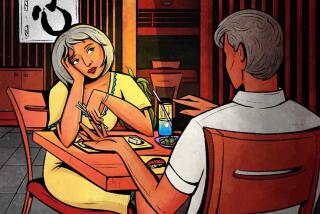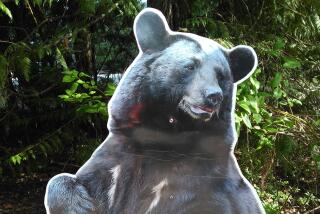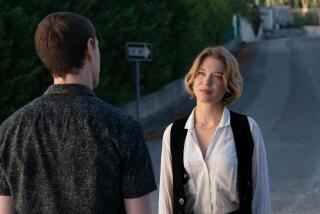An Unlikely Sex Symbol : Idealized Romance, Compassion Bring Out the Beauty in ‘Beast’
- Share via
The women of America have fallen in love with a Beast.
When CBS asked Ron Koslow to create a television series based on Jean Cocteau’s 1946 film “Beauty and the Beast,” the network and the writer-producer expected the show, like other fantasy programs, to appeal most strongly to a female audience. The network was banking on that attraction when it scheduled “Beauty and the Beast” to air at 8 p.m. Fridays as lead-in to its two veteran soap operas, “Dallas” and “Falcon Crest,” which also attract a large female viewership.
But no one expected that Vincent, the Beast of this romantic fantasy-drama, would become TV’s most unlikely sex symbol.
Fan mail for Vincent has recently been flooding the production office at a rate of several hundred letters per week. The show, which opened the season ranked 44th in the networks’ prime-time ratings, has recently inched up to 36th. It has won its time slot every week against regular series programming, though it has occasionally lost to specials aired opposite it.
“Beauty and the Beast,” first unveiled at the annual meeting of representatives of CBS-affiliated stations here last summer, was met with suspicion by the mostly male group, some of whom called it “that weird show.” Network executives soothed them by explaining that the series could have the same appeal as the bizarre 1978 hit “The Incredible Hulk.”
Instead of comic-book aficionados, however, “Beauty and the Beast,” a Ron Koslow Films and Witt/Thomas production in association with Republic Pictures, has attracted women--women who have willingly forsaken the monosyllabic Don Johnsons, the slick Harry Hamlins, the sensitive tough-guy Tom Selleck types and the roguish Bruce Willises because they’re dazzled by the beauty of the Beast.
Who is this guy, anyway?
The actor behind the Beast is Ron Perlman, 37, a family man best known for his portrayals of a prehistoric tribesman in the feature film “Quest for Fire” and the tragic hunchback in “The Name of the Rose,” adapted from the brooding Umberto Eco novel.
Koslow, who wrote the show’s pilot episode, created the character. Rick Baker designed the elaborate Beast makeup, which takes five hours to apply.
Koslow, Perlman and Baker all love Vincent enough themselves to offer their own unscientific theories on why women have fallen for the 6-foot-2, 205-pound, excessively hairy gentleman with the cascading blond locks, the feline face, the superhuman strength, the heart of platinum and the dulcet voice that seems created solely for reading Browning’s “Sonnets From the Portuguese.”
And though it may not have been the first notion to occur to the network’s research department, experts on the psychology of relationships call the outpouring of feminine passion as natural as rain.
First, a few details of Vincent’s history: The Beast is a freak of nature, born grotesquely deformed and left to die but miraculously rescued by a man he calls Father (Ray Dotrice). Father, a scholarly recluse who had created his own world in a maze of steam tunnels beneath New York City, gave Vincent a classical education, a noble spirit and shelter from the pain and ridicule he would have experienced in the world above.
Vincent is in love with Catherine Chandler, a wealthy socialite lawyer played by Linda Hamilton. In the pilot episode, Catherine was attacked in the street, her face brutally slashed. Like Vincent, she was left to die until rescued and nursed back to health by the Beast; she did not see her savior until the bandages came off.
Shocked at first, Catherine came to appreciate Vincent for his heart rather than his appearance. The two continue a secret, chaste and tragically impossible romance. Moreover, Vincent can sense Catherine’s emotions and instinctively knows when she’s in danger.
Psychologist Lonnie Barbach, a member of the clinical faculty of the University of California, San Francisco, and author of the recently published book “Erotic Interludes: Tales Told for Women” and seven other books on relationships and sexuality, said the Vincent-Catherine relationship perfectly fits most women’s romantic ideal.
Barbach said the beauty-beast relationship is a classic one in which two lovers are separated by an insurmountable barrier--in this case, being from different species.
Some writers have suggested that the chaste romance might be particularly apt in the era of AIDS; Barbach disputed that theory, saying that such appeal is historic and timeless.
“That’s why the romance novels are so popular,” she said. “There’s often a great deal of disparity between the two people--a poor woman and a very wealthy man (for example). It’s purer than pure. The women who are looking to these novels are looking to be rescued, to be taken care of--to being nurtured, to being treated as if they were some precious jewel.”
Barbach added that the fact that the romance cannot be consummated only adds to its appeal. “He adores her and he cherishes her. Who cares about the sex?” she said.
Jerald Jellison, a professor of psychology at the USC who specializes in personal relationships, said Vincent possesses two of the top five attributes that research indicates women want most in a man: understanding and an idealistic sense of romance. He said the need for nurturing is particularly strong in people who hold low positions of power, a group that includes many women.
Jellison said the Beast’s plight taps into a need common to men and women--to be appreciated despite their appearance, or to be loved for giving that gift to someone else.
“There is a very, very strong appeal to the person who is misunderstood, the loner,” he said. “And part of the appeal is you can see their real worth, you can see beyond the surface, you are fighting to get in there and touch the person. It’s kind of a savior complex.”
Conversely, Jellison said, people want that respect, and tune in to “Beauty and the Beast” because their spouse may be too busy watching football to provide it.
“We want people to treat us with more understanding: ‘You shouldn’t worry about me because I’m a little overweight, because I smoke, because I’m not as pretty as someone else,’ ” he said.
Barbach said that, despite the universal need for such respect, the show would not work if the sexual roles were reversed.
“You probably wouldn’t have the same thing if the Beast were a woman,” she said. “It’s just not the way men are wired. Men are much more aroused by visual stimulation, by the way somebody looks. They wouldn’t want someone who is just going to take care of them and whisper the soft nothings. It’s just not going to work.”
Though crediting women with appreciating the more spiritual side of romance, Barbach said that in this case the attraction is partly physical. The Beast may not be human, but he’s definitely not ugly.
That was the intention of makeup designer Baker.
“The major concern was where to draw the line between animal and human,” he said. “He had to be beastly, but also elegant and attractive. In the story, the lady has to love this character.”
Baker said he combined the “ferocious but attractive” qualities of a lion with those of a tall, handsome man, and added a long, rock-star mane of hair that might be appropriate to either one.
Koslow calls his “Beauty and the Beast” “a classical love story in contemporary terms,” and said he believes the Beast’s ability to sense Catherine’s feelings provides a consummation that is in some ways deeper than sex.
He modestly attributes much of the Beast’s appeal to Perlman’s acting ability. “Aside from his voice, which is pretty magical, he is really able to plumb the depths, to get to the core of an emotion and just strip-mine it,” he said.
And Perlman, with equal modesty, attributes the phenomenon to Koslow’s conception of the Beast.
“This character is so incredibly attractive in who he is, humanistically,” he said. “It’s as classical a role as I’ve ever had, Shakespeare included.
“I think now is the best time for it (the show). I have complained for years that the media, on every level, have given the world more than it wants or needs to know. What this show is is a return to Gothic romance--the main thrust of the drama is unspoken, not acted out. That consummation is supplied by the viewer, and I think the viewer is grateful without ever knowing why.”
Perlman would not turn over any of his fan mail, believing it would be ungentlemanly to print private correspondence in a newspaper. (He also has turned down countless requests to promote products in Beast makeup: “He’s not there to be exploited”).
But he revealed that in addition to the usual requests for dates or personal data, he also receives letters from people who have physical deformities or terminal illnesses who empathize with the Beast’s life. “They’re very literate letters--we’re reaching a very educated audience,” he said.
Perlman added that he hopes more men will begin to tune into the show, because he thinks it offers hope to them as well.
“If you’ve ever been turned down as a young guy, asking a girl for a date or to the prom, you have to deal with it: ‘Don’t they know that just because I’m not beautiful, I might show them the best time they’ve ever had?’ That’s the Beast.”
More to Read
The complete guide to home viewing
Get Screen Gab for everything about the TV shows and streaming movies everyone’s talking about.
You may occasionally receive promotional content from the Los Angeles Times.






